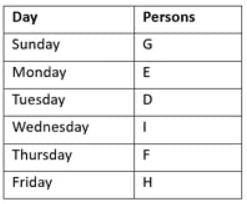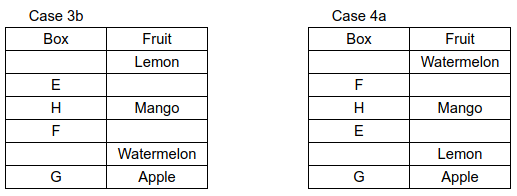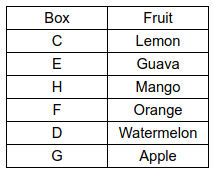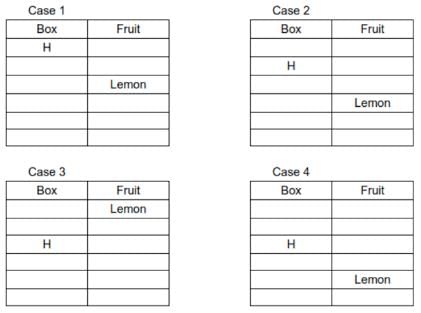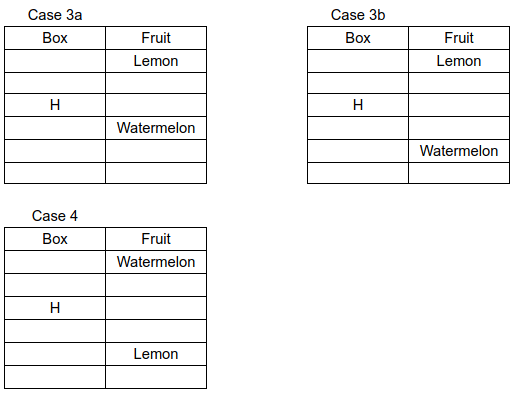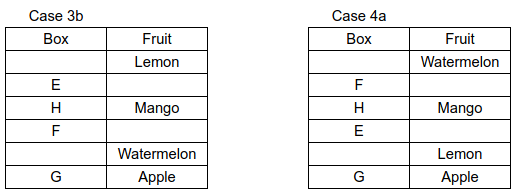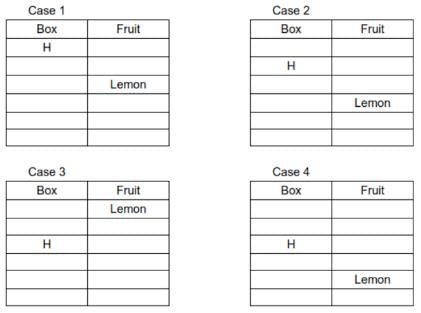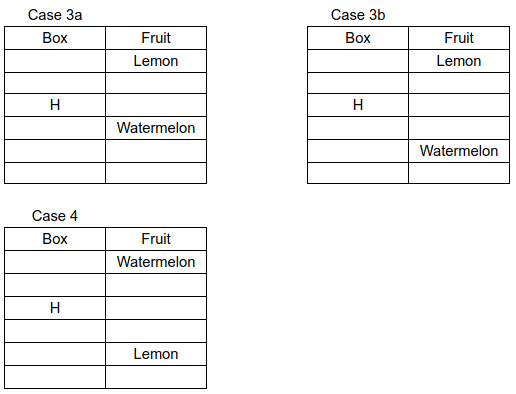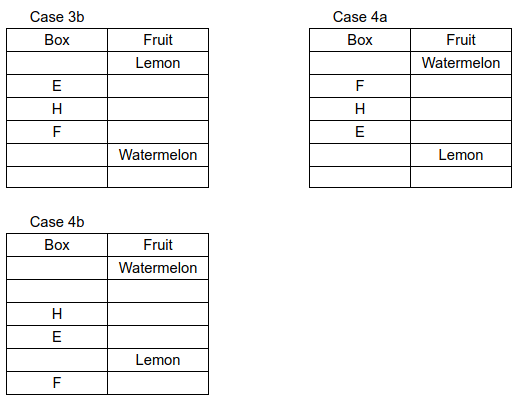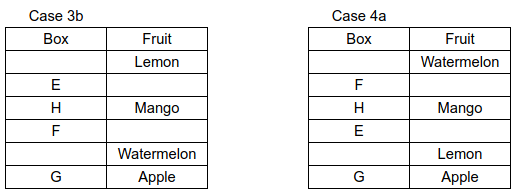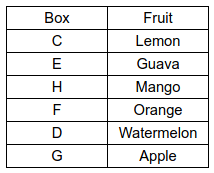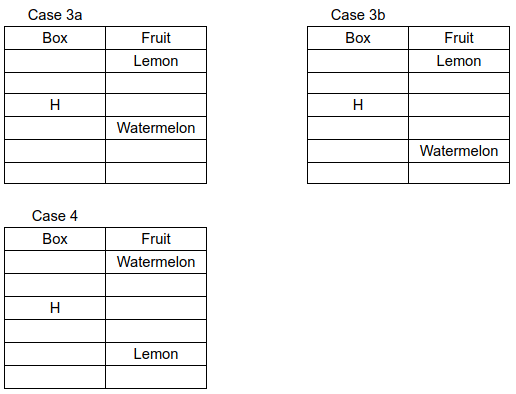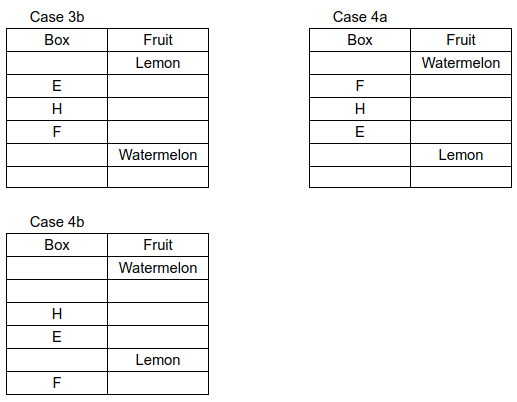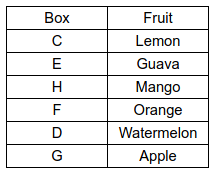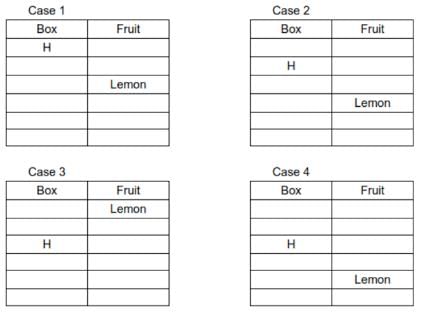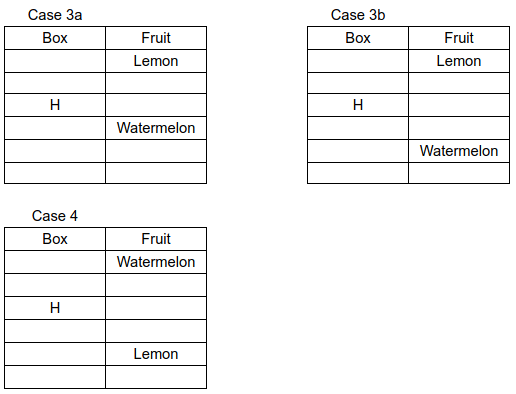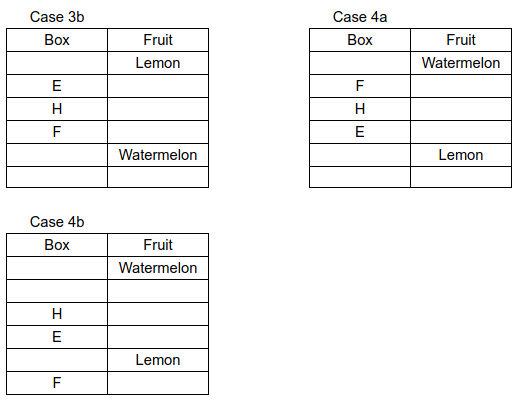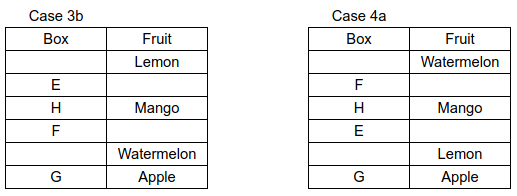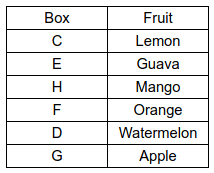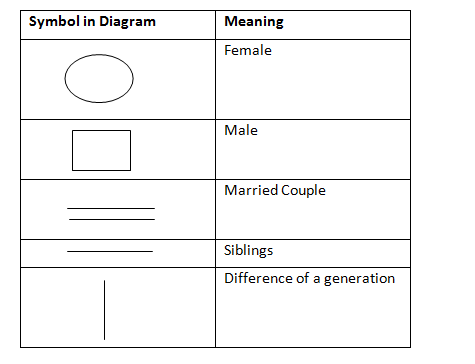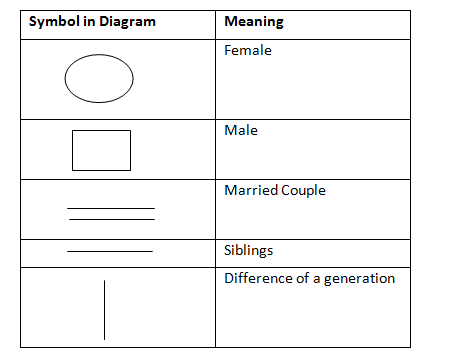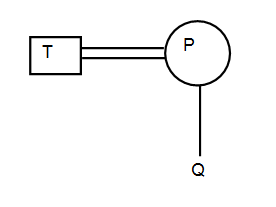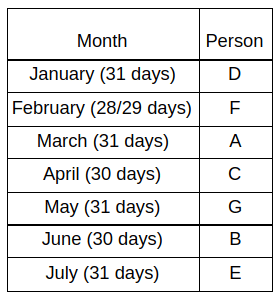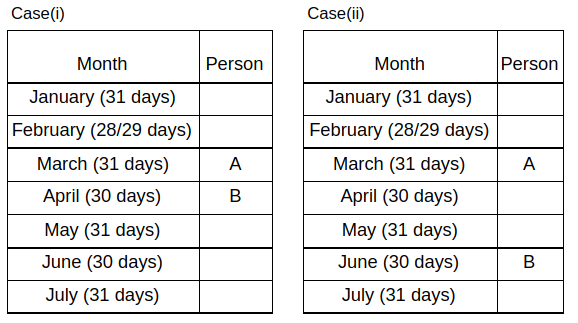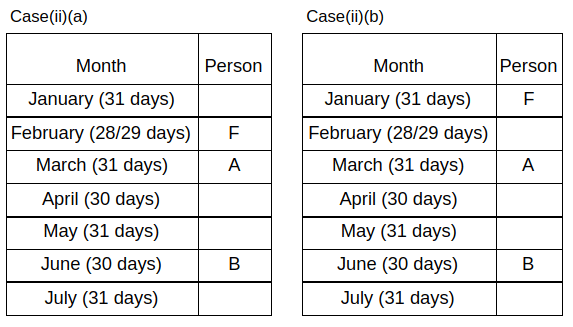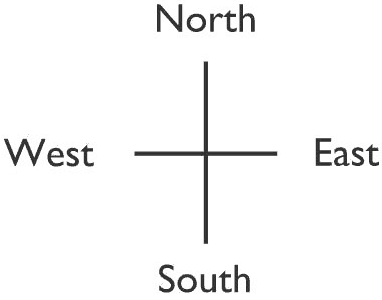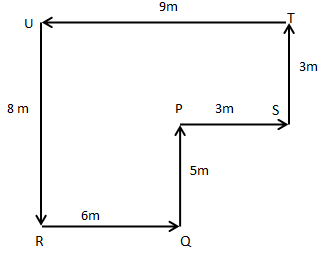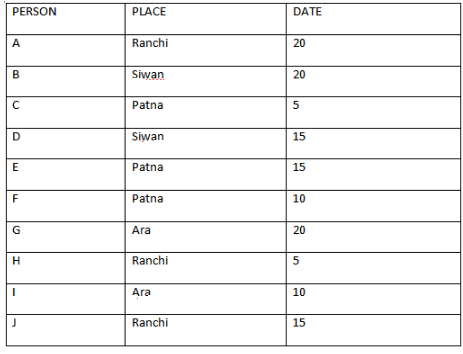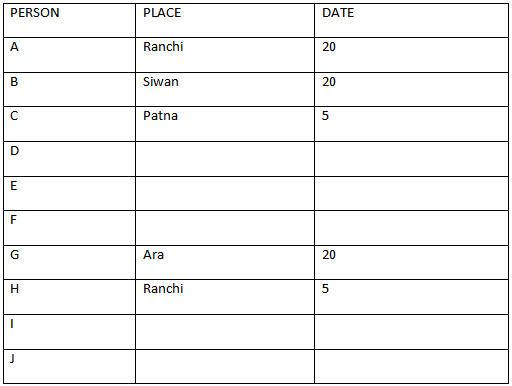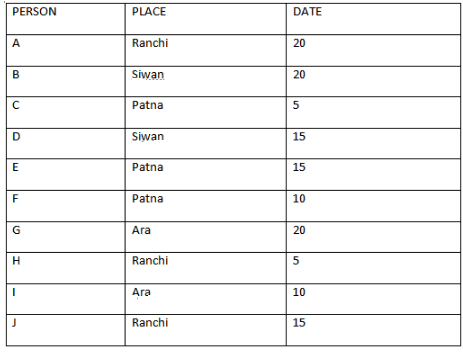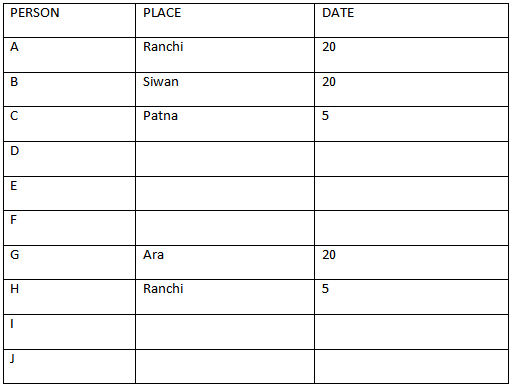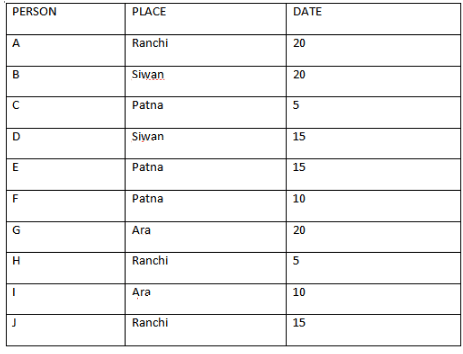IBPS RRB Clerk Mains Mock Test - 7 - Bank Exams MCQ
30 Questions MCQ Test - IBPS RRB Clerk Mains Mock Test - 7
Study the following information carefully and answer the questions.
A % B(13) means ‘A is 17m South of B’
A $ B(24) means ‘B is 20m West of A’
A # B(18) means ‘A is 14m East of B’
A & B(32) means ‘B is 36m North of A’
Solve the below expressions using the above logics and answer the given questions.
C # H(44), J & H(16), J $ K(14), Y % K(6), W # Y(14), W & Z(16), S $ Z(24), T & S(6)
Q. What is the direction of point T with respect to point K?
Direction Text: The questions given below contain two statements giving certain data. You have to decide whether the data given in the statements are sufficient for answering the question. Read both statements and give answer- (A) If statement I alone is sufficient but statement II alone is not sufficient. (B) If statement II alone is sufficient but statement I alone is not sufficient (C) If each statement alone (either I or II) is sufficient (D) If statement I and II together are not sufficient (E) If both statement together are sufficient but neither statement alone is sufficient.
Six persons D, E, F, G, H and I are attending the interview on six different days of the week starting from Sunday.
Q. Who is attending the interview on Wednesday?
Statement I: More than two persons attending the interview between E and H. D attends the interview immediately before I. Two persons attending the interview between E and F.
Statement II: Number of persons attending the interview before E and after F are equal. More than one person attends the interview between D and H.
Read the following information carefully and answer the questions given below:
Six boxes C, D, E, F, G and H are arranged one above the other but necessarily in the same order. Each box has different fruits namely Mango, Apple, Guava, Orange, Lemon and Watermelon but not necessarily in the same order.
Box C is placed above box D. The box containing watermelon is not placed immediately above H. Atleast two boxes are placed between the box containing watermelon and the box containing lemon. Two boxes are placed between G and the box containing mango. The box containing guava is placed above the box containing orange. Less than three boxes are placed above H. The box containing watermelon is not placed at the bottom of the stack. Box G contains apple. One box is placed between F and E. One box is placed between the box containing lemon and H. Two boxes are placed between the box containing watermelon and E. Box F do not contain Guava.
Q. Which of the following fruits does box C contain?
Read the following information carefully and answer the questions given below:
Six boxes C, D, E, F, G and H are arranged one above the other but necessarily in the same order. Each box has different fruits namely Mango, Apple, Guava, Orange, Lemon and Watermelon but not necessarily in the same order.
Box C is placed above box D. The box containing watermelon is not placed immediately above H. Atleast two boxes are placed between the box containing watermelon and the box containing lemon. Two boxes are placed between G and the box containing mango. The box containing guava is placed above the box containing orange. Less than three boxes are placed above H. The box containing watermelon is not placed at the bottom of the stack. Box G contains apple. One box is placed between F and E. One box is placed between the box containing lemon and H. Two boxes are placed between the box containing watermelon and E. Box F do not contain Guava.
Q. Which of the following is odd?
Read the following information carefully and answer the questions given below:
Six boxes C, D, E, F, G and H are arranged one above the other but necessarily in the same order. Each box has different fruits namely Mango, Apple, Guava, Orange, Lemon and Watermelon but not necessarily in the same order.
Box C is placed above box D. The box containing watermelon is not placed immediately above H. Atleast two boxes are placed between the box containing watermelon and the box containing lemon. Two boxes are placed between G and the box containing mango. The box containing guava is placed above the box containing orange. Less than three boxes are placed above H. The box containing watermelon is not placed at the bottom of the stack. Box G contains apple. One box is placed between F and E. One box is placed between the box containing lemon and H. Two boxes are placed between the box containing watermelon and E. Box F do not contain Guava.
Q. If all the boxes are arranged in alphabetical order from top to bottom, then the position of how many boxes remain unchanged?
Read the following information carefully and answer the questions given below:
Six boxes C, D, E, F, G and H are arranged one above the other but necessarily in the same order. Each box has different fruits namely Mango, Apple, Guava, Orange, Lemon and Watermelon but not necessarily in the same order.
Box C is placed above box D. The box containing watermelon is not placed immediately above H. Atleast two boxes are placed between the box containing watermelon and the box containing lemon. Two boxes are placed between G and the box containing mango. The box containing guava is placed above the box containing orange. Less than three boxes are placed above H. The box containing watermelon is not placed at the bottom of the stack. Box G contains apple. One box is placed between F and E. One box is placed between the box containing lemon and H. Two boxes are placed between the box containing watermelon and E. Box F do not contain Guava.
Q. How many boxes are placed between Box C and the box which contains Orange?
Read the following information carefully and answer the questions given below:
Six boxes C, D, E, F, G and H are arranged one above the other but necessarily in the same order. Each box has different fruits namely Mango, Apple, Guava, Orange, Lemon and Watermelon but not necessarily in the same order.
Box C is placed above box D. The box containing watermelon is not placed immediately above H. Atleast two boxes are placed between the box containing watermelon and the box containing lemon. Two boxes are placed between G and the box containing mango. The box containing guava is placed above the box containing orange. Less than three boxes are placed above H. The box containing watermelon is not placed at the bottom of the stack. Box G contains apple. One box is placed between F and E. One box is placed between the box containing lemon and H. Two boxes are placed between the box containing watermelon and E. Box F do not contain Guava.
Q. Which of the following box contains Orange?
Read the following information carefully and answer the question given below-
A # B means A is father of B
A * B means A is husband of B
A % B means A is sister of B
A $ B means A is mother B
A @ B means A is brother of B
Q. Which of the following statements is true if the given expression is true?
I # J % K @ U * V % W
Read the following information carefully and answer the question given below-
A # B means A is father of B
A * B means A is husband of B
A % B means A is sister of B
A $ B means A is mother B
A @ B means A is brother of B
Q. If ‘T * P $ Q’ is given, then how is Q related to T?
In the following question, some statements are given followed by some conclusions. You have to take the given statements to be true even if they seem to be at variance with commonly known facts. Read all the conclusions and then decide which of the given conclusions logically follow the given statements, disregarding commonly known facts.
Statement:
A government official said the trend in Aadhaar Enabled Payments System (AEPS) shows there will be a significant demand for microloans. Most AEPS transactions are done via hand-held devices usually provided through bank mitras or installed at public distribution shops.
Conclusion:
I. Aadhaar Enabled Payments System (AEPS) are easier to use as compared to other modes of payment.
II. Other modes of payment don’t use hand-held devices for the transactions.
In the following question, some statements are given followed by some conclusions. You have to take the given statements to be true even if they seem to be at variance with commonly known facts. Read all the conclusions and then decide which of the given conclusions logically follow the given statements, disregarding commonly known facts.
Statement:
The government expects at least half of the 32 crores Jan Dhan accounts to avail the overdraft facility for Rs 2,000 with no conditions attached, a finance ministry official said, that would translate to a Rs 32,000 crore booster shot for the economy.
Conclusions:
I. More than half of Jan Dhan accounts will use the overdraft facility provided by the government.
II. The overdraft facility would provide the much-needed boost to the economy.
In each question given below, Some statements are followed by two conclusions numbered l and ll. You have to take the given statements to be true even if they seem to be at variance from the commonly known facts. Read the conclusion and decide which logically follows from the given statements disregarding commonly known facts.
(A) If only conclusion l follows.
(B) If only conclusion ll follows.
(C) If either conclusion l or ll follows.
(D) If neither conclusion l nor ll follows.
(E) If both conclusion l and ll follows.
Statement:
The Centre on Wednesday contended that adultery should remain an offence and opposed a petition before the Supreme Court that sought to make men and women equally liable under Section 497 of the Indian Penal Code.
Conclusion:
I. Diluting adultery law will impact the sanctity of marriages and making adultery legal will hurt marriage bonds.
II. Adultery is not considered a criminal offence towards women in India.
Eleven people J, K, L, M, N, O, P, Q, R, S and T are sitting in a linear row such that some of them are facing north and some of them are facing south. Not more than two immediate neighbours face the same direction. The immediate neighbours of R face opposite directions to each other. Q sits exactly between R and N. M and T are not immediate neighbours of each other. The direction of O and J is the same. The number of people sitting between J and Q is the same as the number of people sitting between Q and T who is second to the right of K. The immediate neighbours of S face opposite directions to each other. K does not face the north direction. Five people are sitting between R and J which is second to the left of N. O is immediately left of T. More than three people are sitting between O and L who is second to the right of S. Not more than one person is sitting between M and P.
Q. Which of the following statements are not true?
(i) L and Q are immediate neighbours of each other.
(ii) R sits exactly in the middle of the row.
(iii) People who are sitting at the extreme end of the row face the same direction to each other.
Eleven people J, K, L, M, N, O, P, Q, R, S and T are sitting in a linear row such that some of them are facing north and some of them are facing south. Not more than two immediate neighbours face the same direction. The immediate neighbours of R face opposite directions to each other. Q sits exactly between R and N. M and T are not immediate neighbours of each other. The direction of O and J is the same. The number of people sitting between J and Q is the same as the number of people sitting between Q and T who is second to the right of K. The immediate neighbours of S face opposite directions to each other. K does not face the north direction. Five people are sitting between R and J which is second to the left of N. O is immediately left of T. More than three people are sitting between O and L who is second to the right of S. Not more than one person is sitting between M and P.
Q. Who is sitting third to the right of T and what is the direction of that person?
Eleven people J, K, L, M, N, O, P, Q, R, S and T are sitting in a linear row such that some of them are facing north and some of them are facing south. Not more than two immediate neighbours face the same direction. The immediate neighbours of R face opposite directions to each other. Q sits exactly between R and N. M and T are not immediate neighbours of each other. The direction of O and J is the same. The number of people sitting between J and Q is the same as the number of people sitting between Q and T who is second to the right of K. The immediate neighbours of S face opposite directions to each other. K does not face the north direction. Five people are sitting between R and J which is second to the left of N. O is immediately left of T. More than three people are sitting between O and L who is second to the right of S. Not more than one person is sitting between M and P.
Q. If all the people are arranged in alphabetical order starting from left to right, then the position of how many people remain unchanged?
Eleven people J, K, L, M, N, O, P, Q, R, S and T are sitting in a linear row such that some of them are facing north and some of them are facing south. Not more than two immediate neighbours face the same direction. The immediate neighbours of R face opposite directions to each other. Q sits exactly between R and N. M and T are not immediate neighbours of each other. The direction of O and J is the same. The number of people sitting between J and Q is the same as the number of people sitting between Q and T who is second to the right of K. The immediate neighbours of S face opposite directions to each other. K does not face the north direction. Five people are sitting between R and J which is second to the left of N. O is immediately left of T. More than three people are sitting between O and L who is second to the right of S. Not more than one person is sitting between M and P.
Q. How many people face the north direction?
Eleven people J, K, L, M, N, O, P, Q, R, S and T are sitting in a linear row such that some of them are facing north and some of them are facing south. Not more than two immediate neighbours face the same direction. The immediate neighbours of R face opposite directions to each other. Q sits exactly between R and N. M and T are not immediate neighbours of each other. The direction of O and J is the same. The number of people sitting between J and Q is the same as the number of people sitting between Q and T who is second to the right of K. The immediate neighbours of S face opposite directions to each other. K does not face the north direction. Five people are sitting between R and J which is second to the left of N. O is immediately left of T. More than three people are sitting between O and L who is second to the right of S. Not more than one person is sitting between M and P.
Q. How many people are sitting to the right of S?
Read the following information carefully and answer the question given below.
Two trucks start from the opposite places of a main road, 150km, apart. First truck runs for 25km, and takes a right turn and then runs 15km. It then turns left and then runs for another 25km, and then takes the direction back to reach the main road. In the meantime, due to minor break down the other truck has run only 35km, along the main road.
Q. In which direction is second truck from the first truck?
Read the following information carefully and answer the question given below.
Two trucks start from the opposite places of a main road, 150km, apart. First truck runs for 25km, and takes a right turn and then runs 15km. It then turns left and then runs for another 25km, and then takes the direction back to reach the main road. In the meantime, due to minor break down the other truck has run only 35km, along the main road.
Q. What would be the distance between two trucks at this point?
Read the following information carefully and answer the question given below.
Two trucks start from the opposite places of a main road, 150km, apart. First truck runs for 25km, and takes a right turn and then runs 15km. It then turns left and then runs for another 25km, and then takes the direction back to reach the main road. In the meantime, due to minor break down the other truck has run only 35km, along the main road.
Q. Starting point of first truck is in which direction of main road?
Direction Text: Each of the question below consists of one question and some statements given below it. Read all the statements carefully and find out which of the statement is/are sufficient to answer the given question.
Q. How is Sneha related to Divya?
I. Sneha who has two children is the daughter of Indu. Indu has only one granddaughter named Divya.
II. Vijay who is the brother of Sneha has only one child named Ayushi..
Direction Text: Each of the question below consists of one question and some statements given below it. Read all the statements carefully and find out which of the statement is/are sufficient to answer the given question.
Q. Who stays at 4th floor of the building having 5 floors (1st is the bottommost floor and 5th is the topmost floor, also ground floor is empty)?
I. Manoj stays on an odd-numbered floor.
II. Ajay stays three floors above Manoj.
Study the following series carefully and answer the questions.
F#5N3U>2K8D6@YS2E&7!W8P%4A1M9X=L3V<
How many letters are immediately preceded by a number but not immediately followed by a number?
Direction Text: Each of the question below consists of one question and some statements given below it. Read all the statements carefully and find out which of the statement is/are sufficient to answer the given question.
How is ‘blue’ written in that code?
I. In a certain code, ‘pink and blue’ is written as ‘ki vo tu’ in that code language.
II. In a certain code, ‘spread blue carpet’ is written as ‘ti mi ki’ in that code language.
Seven people A, B, C, D, E, F and G appeared for the interview during seven different months from January to July of the same year. C appeared for the interview in which of the following months?
Statement I) D appeared for the interview in a month which has a maximum number of days. Four people appeared for the interview between D and B who appeared for the interview immediately after G. The number of people who appeared for the interview before G and after A is the same. At Least one person appeared for the interview between A and E. F did not appear for the interview after C.
Statement II) B appeared for the interview in a month which is having 30 days. More than two people appeared for an interview between B and F. One person appeared for the interview between F and C. More than one person appeared for the interview between C and E. A appeared for the interview in march.
Read the following information carefully and answer the questions given below.
! → North
^ → South
* → West
$ → East
# → Either 5 or 9 meters
& → Either 3 or 8 meters
A ^ B means A is south of B.
A & B means A is either 3 or 8 meters from B.
A !* B means A is north-west of B.
A * # B means A is west of B, and A is either 5 or 9 meters from B.
Point P is 5 meters north of point Q, which is 6 meters away from point R.
I. S $ P
II. P & S
III. T !& S
IV. U *# T
V. U !* Q
VI. R ^& U
VII. R * Q
Q. What is the direction of point P with respect to point U?
Garima was born on which of the following days of a week?
Statement I) Garima’s uncle correctly remembers that she was born after wednesday but before saturday.
Statement II) Garima’s father correctly remembers that she was born before friday.
Read the following information carefully and answer the question given below-
Ten friends A, B, C, D, E, F, G, H, I and J travel to different cities namely Ranchi, Patna, Siwan and Ara on four different dates such as 5, 10, 15 and 20 of a month but not necessarily in the same order. No two persons travelling the same city travel on the same date. Minimum of two persons travels one city. At least two people travel on the same date.
A is travelling to Ranchi on 20. C either travels to Patna or Ranchi. H travels to Ranchi on 5. E and F both travel to Patna but none of them travels on 20. J travels on 15 of the month. I travel to Ara either on 10 or 20 of the month. B travels to Siwan on 20. G travels on 20. E travels on 15. The one travelling to Siwan leaves on 15 of the month. G travels to Ara. D travels to Siwan. Three people travel to Ranchi.
Q. F travels to which city?
Read the following information carefully and answer the question given below-
Ten friends A, B, C, D, E, F, G, H, I and J travel to different cities namely Ranchi, Patna, Siwan and Ara on four different dates such as 5, 10, 15 and 20 of a month but not necessarily in the same order. No two persons travelling the same city travel on the same date. Minimum of two persons travels one city. At least two people travel on the same date.
A is travelling to Ranchi on 20. C either travels to Patna or Ranchi. H travels to Ranchi on 5. E and F both travel to Patna but none of them travels on 20. J travels on 15 of the month. I travel to Ara either on 10 or 20 of the month. B travels to Siwan on 20. G travels on 20. E travels on 15. The one travelling to Siwan leaves on 15 of the month. G travels to Ara. D travels to Siwan. Three people travel to Ranchi.
Q. I travels on which date?
Read the following information carefully and answer the question given below-
Ten friends A, B, C, D, E, F, G, H, I and J travel to different cities namely Ranchi, Patna, Siwan and Ara on four different dates such as 5, 10, 15 and 20 of a month but not necessarily in the same order. No two persons travelling the same city travel on the same date. Minimum of two persons travels one city. At least two people travel on the same date.
A is travelling to Ranchi on 20. C either travels to Patna or Ranchi. H travels to Ranchi on 5. E and F both travel to Patna but none of them travels on 20. J travels on 15 of the month. I travel to Ara either on 10 or 20 of the month. B travels to Siwan on 20. G travels on 20. E travels on 15. The one travelling to Siwan leaves on 15 of the month. G travels to Ara. D travels to Siwan. Three people travel to Ranchi.
Q. How many people travel Patna?



